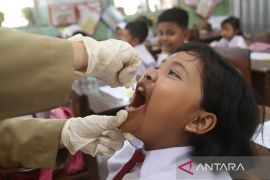Head of the cancer and blood disorders working team of the ministry's Directorate of Prevention and Control of Non-Communicable Diseases, Dr. Theresia Sandra Diah Ratih, on Thursday informed that the global incidence of cervical cancer stands at 13 out of 100 thousand population.
Meanwhile, in Indonesia, the ratio is 23.3 per 100 thousand population — twice the global figure.
"The mortality rate is also the same. If the mortality rate of cervical cancer in the world is around 7.3, we still have 13.3, it is almost double the number," she highlighted.
She then outlined 2022 data from the International Agency for Research on Cancer, which estimated 408 thousand new cancer cases and almost 243 thousand deaths due to cancer in Indonesia.
Ratih said that Indonesia has conducted overall preventive efforts to reduce cervical cancer cases, including through vaccination and treatment.
However, the nation is facing challenges related to cancer treatment since most cases are detected at more advanced stages, leading to higher treatment costs, she added.
"Some 99 percent of cervical cancer is due to persistent infection or ongoing infection from oncogenic human papillomavirus. So, some human papillomaviruses are oncogenic, some are not oncogenic," she explained.
Related news: Prevent cervical cancer through vaccination, safe sex: Ministry
By building awareness that the HPV virus can cause cancer, prevention can be made easier, including the discovery of precancerous lesions, Ratih said.
"So before it reaches cancer, we can also detect it. Because we can treat the cancer at an early stage more easily. Therefore, the WHO's (World Health Organization's) global strategy determines that 90 percent of girls must be vaccinated against HPV," she added.
Another step recommended by the WHO is carrying out a high-performance test for 70 percent of women aged 35–45 years. In addition, 90 percent of women with precancerous lesions should receive treatment according to the set standard.
According to her, these steps could help eliminate cervical cancer in the next 20–30 years. In addition, the ministry is making health transformations to speed up the elimination process.
The transformations consist of four pillars, namely the provision of services consisting of vaccination, screening, and management.
"Then, the second pillar is education, where we will strengthen education for health workers to increase their capacity and ability to provide service. We will also increase public awareness and education to encourage people to carry out immunization and vaccination," she informed.
The third pillar is encouraging progress through monitoring, evaluation, and research as well as digital enablers, namely reporting recording systems to remind the public about vaccination and screening, among others.
The last pillar is management and organization, which includes governance and policies, then financing for elimination, collaboration, and inter-sector partnerships, Ratih said.
Related news: Ministry provides easy, affordable early cancer detection at Puskesmas
Translator: Mecca Yumna N P, Resinta Sulistiyandari
Editor: Yuni Arisandy Sinaga
Copyright © ANTARA 2024











